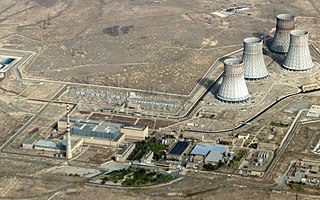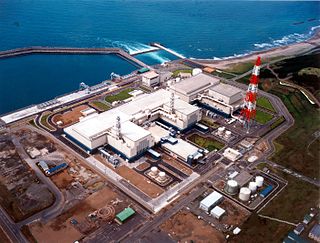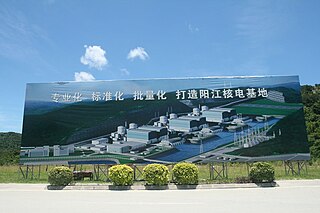
The advanced boiling water reactor (ABWR) is a Generation III boiling water reactor. The ABWR is currently offered by GE Hitachi Nuclear Energy (GEH) and Toshiba. The ABWR generates electrical power by using steam to power a turbine connected to a generator; the steam is boiled from water using heat generated by fission reactions within nuclear fuel. Kashiwazaki-Kariwa unit 6 is considered the first Generation III reactor in the world.

Kaiga Generating Station is a nuclear power generating station situated at Kaiga, near the river Kali, in Uttara Kannada district of Karnataka, India. The plant has been in operation since March 2000 and is operated by the Nuclear Power Corporation of India.

Generation III reactors, or Gen III reactors, are a class of nuclear reactors designed to succeed Generation II reactors, incorporating evolutionary improvements in design. These include improved fuel technology, higher thermal efficiency, significantly enhanced safety systems, and standardized designs intended to reduce maintenance and capital costs. They are promoted by the Generation IV International Forum (GIF).

The Armenian Nuclear Power Plant (ANPP), also known as the Metsamor Nuclear Power Plant, is the only nuclear power plant in the South Caucasus, located 36 kilometers west of Yerevan in Armenia.

Tarapur Atomic Power Station (T.A.P.S.) is located in Tarapur, Palghar, India. It was the first commercial nuclear power station built in India.

The Kashiwazaki-Kariwa Nuclear Power Plant is a large, modern nuclear power plant on a 4.2-square-kilometer (1,000-acre) site. The campus spans the towns of Kashiwazaki and Kariwa in Niigata Prefecture, Japan, on the coast of the Sea of Japan, where it gets cooling water. The plant is owned and operated by Tokyo Electric Power Company (TEPCO), and it is the largest nuclear generating station in the world by net electrical power rating.

The Kori Nuclear Power Plant is a South Korean nuclear power plant located in Kori, a suburban village in Busan. It is the world's second largest fully operational nuclear generating station by total reactor count and the number of currently operational reactors since 2016, after it exceeded in nameplate capacity Canada's Bruce Nuclear Generating Station. It is owned and operated by Korea Hydro & Nuclear Power, a subsidiary of KEPCO. The first reactor began commercial operation in 1978 and operated until 2017 when it was decommissioned. Units 2, 3, and 4 started commercial operations in the 1980s. All reactors on site are pressurized water reactors.

Kakrapar Atomic Power Station is a nuclear power station in India, which lies in the proximity of Mandvi, Surat and Tapi river in the state of Gujarat.
The Rajasthan Atomic Power Station is a nuclear power plant located at Rawatbhata in the state of Rajasthan, India.

Tianwan Nuclear Power Plant is a nuclear power plant (NPP) on the coast of the Yellow Sea, approximately 30 kilometers east of downtown Lianyungang, Jiangsu Province, China. The plant's owner is Jiangsu Nuclear Power Corporation, a joint venture with majority owner a subsidiary of China National Nuclear Corporation (CNNC).
The Hongyanhe Nuclear Power Plant (红沿河核电站) is located in Donggang Town, Wafangdian in Liaoning Province of China. The site is within the Prefecture-level city of Dalian, 104 kilometres (65 mi) north of Dalian City proper. The first unit started commercial operations in June 2013.

Narora Atomic Power Station (NAPS) is a nuclear power plant located in Narora, Dibai Tehsil, Bulandshahar District in Uttar Pradesh, India.
Fangjiashan Nuclear Power Plant (方家山核电站) is a nuclear power plant in the Zhejiang province, China, bordering the Shanghai municipality. The plant consists of two 1,080 MW CPR-1000 pressurized water reactors (PWR) at a total cost of estimated 26 billion yuan.

The Wolseong Nuclear Power Plant, or Wolsong, is a nuclear power plant located on the coast near Nae-ri, Yangnam-myeon, Gyeongju, North Gyeongsang province, South Korea. It is the only South Korean nuclear power plant operating CANDU-type PHWR. Korea Hydro & Nuclear Power owns the plant. These reactors are capable of consuming multiple types of fuel, including wastes from South Korea's other nuclear plants.

The Yangjiang Nuclear Power Station is a nuclear power plant in Guangdong province, China. The site is Dongping Town, Yangjiang City in western Guangdong Province. The station has six 1,000 megawatt (MW) CPR-1000 pressurized water reactors (PWRs). The plant began commercial operation in March 2014, and as of 2019 is the largest nuclear power station in China.

The Hanul Nuclear Power Plant is a large nuclear power station in the North Gyeongsang Province of South Korea. The facility has six pressurized water reactors (PWRs) with a total installed capacity of 5,881 MW. The first went online in 1988. In the early 2000s it was the third largest operational nuclear power plant in the world and the second largest in South Korea. The plant's name was changed from Uljin to Hanul in 2013.

The Hanbit Nuclear Power Plant is a large nuclear power station in the Jeollanam-do province of South Korea. The facility runs at an installed capacity of 5,875 MW. The power station is currently ranked as the fifth largest nuclear power station in the world. The plant's name was changed from Yeonggwang NPP to Hanbit in 2013 at the request of local fishermen.
The Darkhovin Nuclear Power Plant is a planned nuclear power plant located in Khuzestan province, Iran about 70 kilometers south of Ahvaz at the Karun river. Construction of one reactor has started. Some other projects on this site were cancelled. It's built by Masna.

































